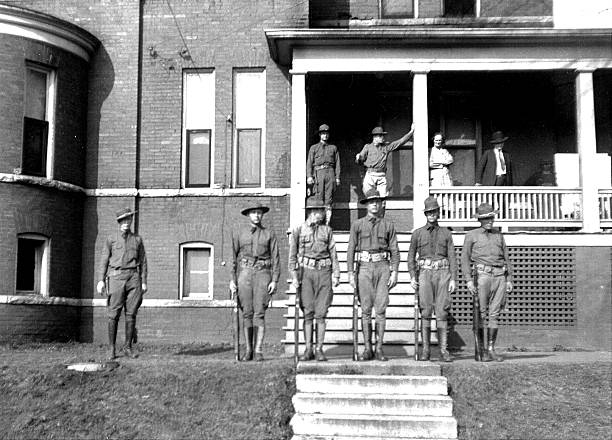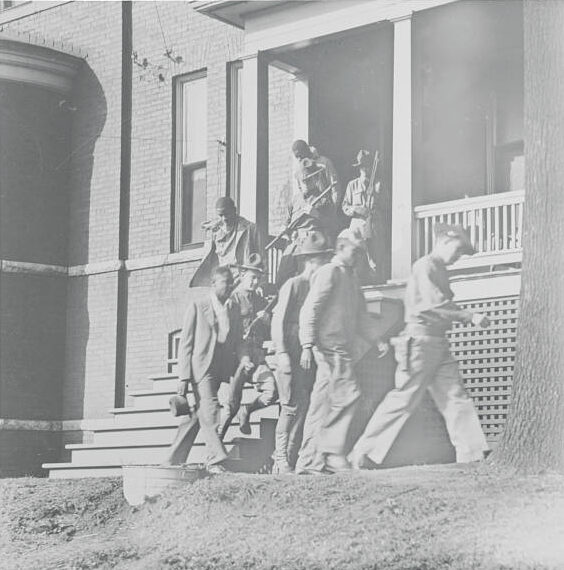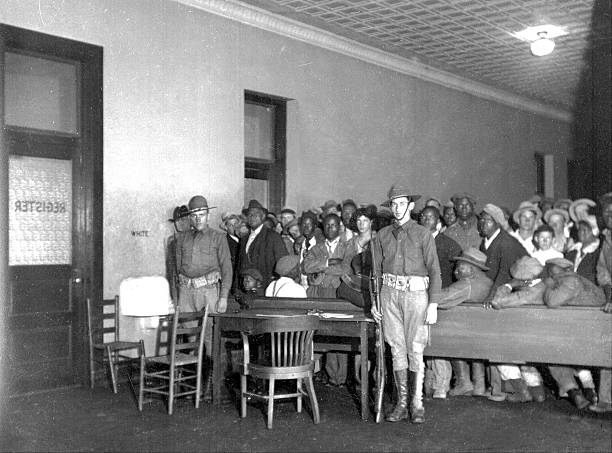
UNITED STATES – MARCH 30: Scottsboro Case – National Guardsmen on duty outside the Decatur, Alabama courthouse where the Scottsboro trial is underway. (Photo by NY Daily News Archive via Getty Images)

(Original Caption) Scottsboro Case “Victim” Swears Frame-Up. The courtroom was suddenly and dramatically surprised in Decatur, Alabama, during the trial of the famous, “Scottsboro Case”, when Ruby Bates, missing “victim” of the seven Negroes, was placed on the stand where she testified she had not been by any of the colored youths, and that to the best of her knowledge, Victoria Price, the other “victim”, had not been assaulted either. This photo shows the Negroes, under heavy guard, being brought from jail to court for the session.

UNITED STATES – MARCH 30: Scottsboro Case – National Guardsmen on duty inside the courthouse to prevent trouble. (Photo by NY Daily News Archive via Getty Images)

Judge:
Judge James Horton-judge that is seen through most of the case, but it put off by the Alabama Supreme Court when he suspends the death sentence for Haywood Patterson and calls for a new trial. He lost re-election the next year, but said in Latin a phrase that translates to this in English “Let justice be done though the heavens may fall.”
Sponsors:
International Labor Defense (ILD)
-The International Labor Defense (ILD) was a legal defense organization in the United States, headed by William L. Patterson. It was a US section of the International Red Aid organization and associated with the Communist Party USA.
-It was formed in 1925, and in 1946 merged with the National Federation for Constitutional Liberties to form the Civil Rights Congress.
-National Association for the Advancement of Colored People (NAACP)-
-Founded Feb. 12. 1909, the NAACP is the nation’s oldest, largest, and most widely recognized grassroots-based civil rights organization.
-The mission of the National Association for the Advancement of Colored People is to ensure the political, educational, social, and economic equality of rights of all persons and to eliminate race-based discrimination.
Event/News:
Timeline:
1931
March 26: A lynch mob of over one hundred people gathers around Scottsboro’s Jail, the National Guard is called by Alabama’s Governor, B.M. Miller.
March 30: All-white jury indicts the “Scottsboro Boys” of rape. The boys are not allowed contact with friends or family and do not get to consult an attorney. The boys’ plea “not guilty.”
April 6: The trials begin
April-December: NAACP and International Labor Defense (ILD) fight over who will handle the appeal, the boys choose ILD
1932
November 7: Powell vs. Alabama, U.S. Supreme Court reverses convictions, on the behalf that the defendants were not allowed the right to counsel; this also violated their right to due process granted to them by the 14th Amendment.
- Bates story to tell the truth after talking to a minister
1933
May 7: March on Washington D.C. to protest the Scottsboro Trials
January: A New York Lawyer Samuel S. Leibowitz is called in by ILD to handle the case
- story of Victoria Price and Dr. R. Bridges
- in one of the later Leibowitz was able to prove that the girls showed no physical trauma of being raped
- Afraid of being arrested for violation of Mann Act crossing state lines for immoral purposes
- Kelby Prison account inmate being put in death chair, Moved to Decatur Scary Prison “unfit for white prisoner”
1935
February 15: Leibowitz argues to the U.S. Supreme Court that black citizens were excluded from the jury.
April 1: U.S. Supreme Court finds that under the 14 Amendment that excluding Blacks from the jury violates equal protection under the law; the Norris and Patterson cases are overturned.
1936
January 23: Haywood Patterson was convicted for the fourth time of the rape, but instead of getting the death penalty he is given 75 years; this is the first time in the History of Alabama that a Black person has not been given the death penalty for the rape of white women.
January 24: Ozie Powell attacks police while being transported, is shot in the head, but lives; mentality challenged for the rest of his life.
1937
July: Clarence Norris convicted of rape, sentenced to death; Andy Wright convicted, sentenced to 99 years; Charlie Weems convicted, sentenced to 75 years; Ozie Powell pleads guilty to assaulting Sheriff Edgar Blalock, sentenced to 20 years; Roy Wright and Eugene charges dropped because of age at the time of the crime, and years already served in prison; Olen Montgomery and Willie Roberson charges dropped because the state no longer sees them as guilty
October 26: The Patterson and Norris conviction are refused to be reviewed by the U.S. Supreme Court
1938
August-November: Four remaining boys are not paroled by Governor Grieves because they upset him
1943
September: Charlie Weems is paroled
1944
January: Norris and Andy Wright paroled
October: Norris Returned to Prison
1946
June: Ozie Powell paroled
1948
July: Haywood Patterson makes a prison break
1950-1951
Haywood Patterson is involved in a barroom fight ending with the death of another man, he is charged with murder.
Patterson is convicted of manslaughter and is sentenced to 6 to 15 years, but he dies of cancer almost a year later.
